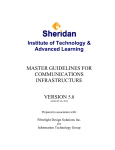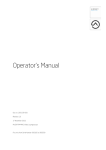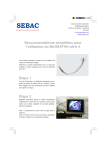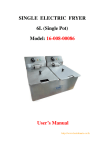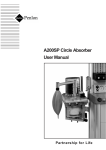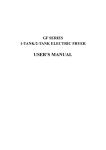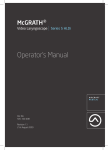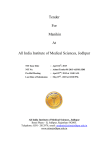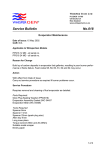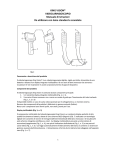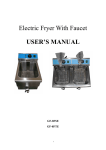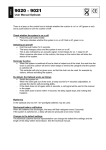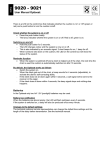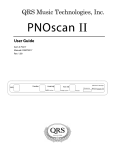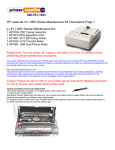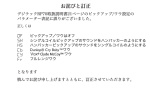Download User Manual View Document
Transcript
Conventional Laryngoscope User Instructions (Including Adjustable, Plastic and McCoy) WARNINGS AND CAUTIONS Read and understand before using these instructions. WARNINGS (to prevent possible personal injury to yourself and others) 1. Tracheal intubation requires specialised training, and laryngoscopes should only be used by personnel who have received such training. 2. The blade of a laryngoscope may transmit infection from patient to patient, and appropriate measures must be taken to clean, disinfect, or sterilise all blades between patients, and to maintain in a sterile state. Blades are not sterile when supplied new. 3. Batteries must not be subjected to heat or immersion in chemicals, and must be removed from the handle prior to disinfection/sterilisation. 4. The power output from some types of batteries (mainly rechargeable) can fall rapidly during use, resulting in the rapid failure of illumination. CAUTIONS (to prevent possible damage to the instrument or other property) 1. USA/Canadian Federal Law restricts this device to sale by or on the order of the physician. 2. Do not attempt to fit a Conventional blade to a Fibrelight type handle 3. Penlon Premier Range blades are only compatible with Premier Range handles CARE IN THE USE OF BATTERIES WARNING Used or defective batteries must not be disposed of in fire as they may explode. They should be treated as containing corrosive and toxic materials. If leakage from a battery makes skin contact, wash at once with large quantities of water. CAUTION Batteries should be removed from instruments when they are not required for use. Corrosive liquids can leak from cells during storage and cause permanent damage to the instrument. NOTE. Do not mix primary (single use) and rechargeable batteries together. PRECAUTIONS FOR USE IN STRONG MAGNETIC FIELDS Most types of battery contain magnetic material and may be subjected to high forces if exposed to strong magnetic fields, e.g. in NMR areas, making the necessary precise control of the laryngoscope difficult. Lithium batteries overcome the problem, but require special adaption for use in standard handles. Please refer to Penlon Limited for further information. PRE-USE CHECKS The user must perform the following checks before commencing an intubation procedure: 1. Visually check the blade for sharp edges or burrs resulting from mechanical damage. 2. Ensure that the lamp is secure in its housing. 3. Move the blade to the operating position and check that the lamp lights with normal brilliance. Low brilliance may indicate that batteries are nearing exhaustion. In areas where intubation is routinely performed, e.g. operating rooms, it is advisable to have spare instruments available as battery life is short and difficult to predict. OPERATING INSTRUCTIONS WARNING - All models After prolonged use (exceeding approximately 30 seconds), the temperature of the lamp may increase. Avoid prolonged direct contact with skin tissue. Switch off the device until intubation commences. Cat No. 52615 Quality and Assurance in Anaesthesia All models - Storage Remove the batteries during storage. Decomposition products from leaking batteries can be corrosive. All models (except Plastic Laryngoscope) Fitting the blade The blade is attached to the handle in the customary 'hook-on' manner. To switch on The laryngoscope lamp will switch on automatically when the blade is moved up to the 'locked on' operating position. To switch off Move the blade down from the operating position. Adjustable Handle - Angle adjustment The blade can be used in four positions, as illustrated. To adjust, press the button, and move the blade to the required position. 180o 135o 90o 45o Using the McCoy Blade WARNING Do not grip the lever when removing the blade. Do not apply any pressure, in the directions shown in the illustration, which could force the blade and lever apart. Damage to the linkage may occur, resulting in incorrect action, or stiffness of the adjustable tip. The McCoy blade is assembled to the handle in the normal manner. The lever to operate the tip section will then extend behind the handle. The lever should not be touched during the initial stage of use, until the tip of the laryngoscope has been inserted into the vallecula. Once this stage has been reached, movement of the lever towards the handle will elevate the tip of the blade, and therefore lift the epiglottis, without the need to increase the force exerted by the main part of the blade. Release the lever before withdrawing the blade. Battery change (all models, except Plastic laryngoscopes) Unscrew the handle end cap, replace batteries - see below. Check configuration and polarity as illustrated. Test before clinical use Handle Standard Penlight & Stubby Battery (2 per handle) LR14 (U11 or C) LR6 (MN1500 or AA) Standard & Penlight Stubby Plastic Laryngoscope Storage Remove the batteries during storage. Decomposition products from leaking batteries can be dangerous and will adversely affect plastic material (although it is impervious to alcohol, anaesthetic agents and disinfectants). Battery change 1. 2. 3. 4. 5. 6. 7. 8. Paediatric: use two LR6 (MN1500 or AA size) Adult: Use two LR14 (U11 or C size) Align the arrow (1) on the knob / end cap (2) mid-way between 'l' mark (3) and 'O' mark (4). Depress the release catch (5) and push the knob forwards. Turn the knob (2) fully anti-clockwise, and pull off. Fit the new batteries (6), with the +ve terminal towards the blade. Depress the catch (5), and push the knob (2) on. Turn the knob fully clockwise, and pull back. Note that the lamp may operate as the knob is pushed on. 5 4 Turn the knob fully anti-clock wise to the 'Off' position. 1 (Arrow aligned with 'O' mark). Recheck the operation of the lamp. To switch on Turn the knob (2) fully clockwise, to align the arrow (1) with the 'l' mark (3) on the handle body. To switch off Turn the knob fully anti-clockwise, to align the arrow (1) with 'O' (4) on the handle body. 2 Replacement Bulb: Bulb - pack of 5 Part No. 55091 CAUTION Wash hands before fitting a new bulb. To reduce pressure on the bulb during refitment, always remove the batteries before fitting the bulb to a plastic laryngoscope. 3 6 Pre-use check - see information given on page 1 for all models. Cleaning, Disinfection, and Sterilisation Handle - see below Blade - Cleaning and Disinfection - see next page Blade - Sterilisation - Use Ethylene Oxide sterilisation or Nu-Cidex. Do not Autoclave Always read the manufacturer’s instructions before using disinfectant or sterilising solutions. Always test before clinical use. Descriptions and Markings Stainless steel blades are marked on the heel of the blade attachment block to identify the type of blade and its size, as follows; Macintosh MAC Miller MIL Robertshaw RSHAW Seward SEW McCoy McCOY Wisconsin WIS The size is indicated by numbers from 0 (smallest blade) to 4 (largest blade). ROUTINE CARE AND MAINTENANCE Cleaning, Disinfection, and Sterilisation Always comply with local health and safety regulations during these operations. When using disinfectant or sterilising solutions, the manufacturer’s recommended concentrations and time periods must be observed. All Handles - Cleaning and Disinfection WARNING Before cleaning and disinfection, remove the end cap and batteries from the handle. Do not immerse or autoclave the handle assembly on Adjustable / Stubby / Plastic models. 1. Remove the batteries. 2. Scrub the handle externally, using a suitable detergent - follow the disinfectant manufacturer's instructions. Ensure that fluid does not seep into the electrical contact area on Adjustable / Stubby / Plastic models. 3. Check that the handle is dry, inside and outside, before replacing the batteries. 4. Fit a blade to the handle and test the laryngoscope before clinical use. Waterproof Handles - Standard and Penlight Only - Sterilisation 1. 2. 3. 4. Remove batteries, refit the end cap, and clean the handle externally (see above), then: Sterilise, following the instructions given below: (Blades - Sterilisation) After sterilisation, check: A) that the O-ring fitted inside the end cap is in place, and in good condition, B). that the switch assembly is secure Refit the batteries, fit a blade to the handle, and test the laryngoscope before clinical use. Blades (all models) - Cleaning and Disinfection 1. 2. 3. Check that the bulb is fully screwed into its socket before cleaning the blade. Scrub the components after use, preferably under running water. Rinse thoroughly. Do not use abrasive materials, such as wire wool. On the McCoy Laryngoscope, pay particular attention to the distal tip hinge mechanism remove all traces of contamination. Clean the components again with a disinfectant solution - follow the instructions provided by the disinfectant manufacturer. Blades - Sterilisation We recommend either the use of Nu-Cidex solution, or, for metal blades, the use of an autoclave. We do not recommend the use of solutions containing sodium hypochlorite. Nu-Cidex: 1. Check that the bulb is securely screwed into its socket before sterilising the blade. 2. Soak the blade in Nu-Cidex sterilising solutions. Follow the manufacturer's recommendations for solution concentration / soak time period. Caution Do not exceed the manufacturer's recommendations. Autoclave: 1. Autoclave the blade at 134 - 137°C. Caution Comply with the nationally recommended time periods for autoclaving. Plastic Laryngoscope Blade - Do not autoclave Use Ethylene Oxide sterilisation or Nu-Cidex (see Blades above). All Models - After cleaning and sterilisation, always test before clinical use. Cat No 52615 April 2000 Penlon Limited, Radley Road, Abingdon OX14 3PH UK Tel: +44 (0) 1235 547063 Fax: +44 (0) 1235 547062 E-mail: [email protected]





